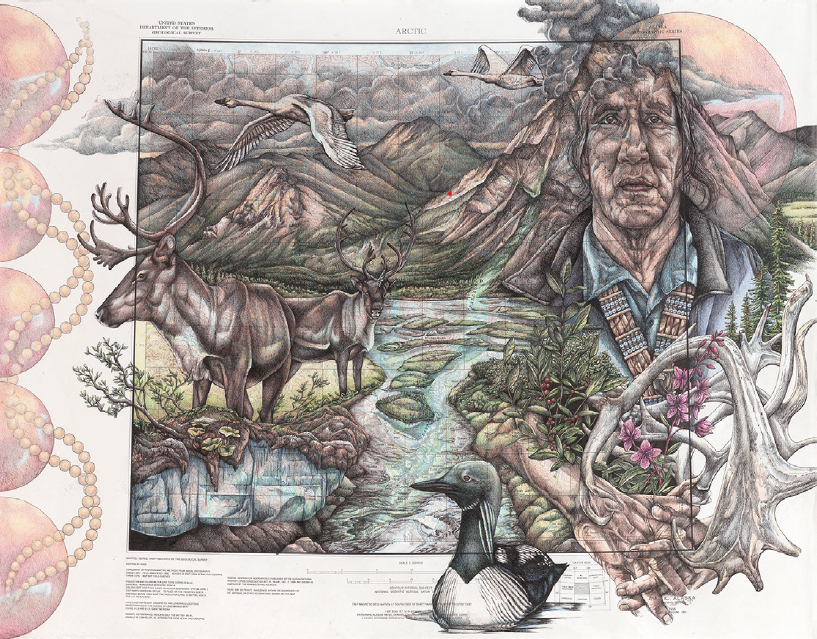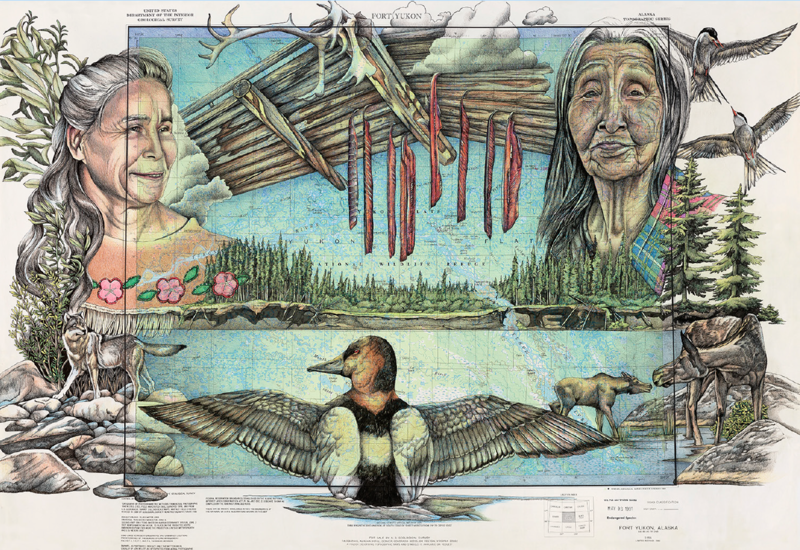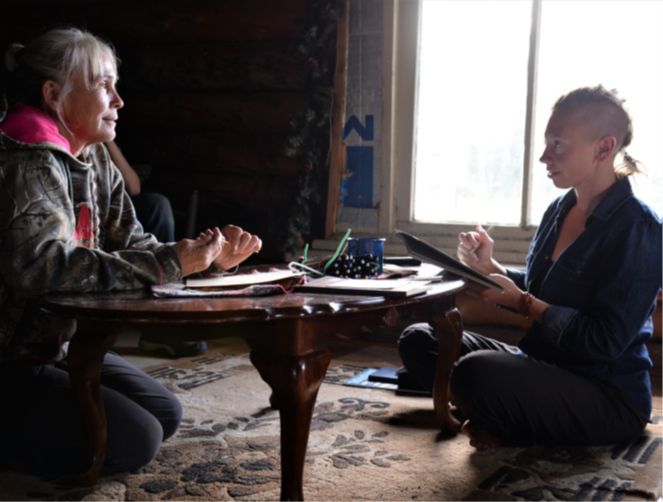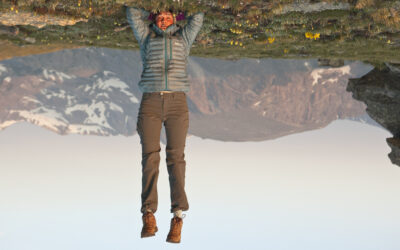Photo by Jonathan Wheeler on Unsplash
Wilderness and Traditional Indigenous Beliefs: Conflicting or Intersecting Perspectives on the Human–Nature Relationship?
Communication & Education
August 2022 | Volume 28, Number 2
A Historical Wilderness Perspective – Roger Kaye
There currently exists a disproportionate focus on the differences between traditional Indigenous beliefs and the wilderness concept, and inadequate recognition of what they have in common. For example, uniting many traditional Indigenous beliefs and the Wilderness concept are fundamental, underlying ideas, values, and guides for behavior relating to:
- Human’s role in the larger world
- The interrelatedness of humans and the larger community of life
- The need for humility, respect, and restraint in relating to nature
These themes comprise what Henry David Thoreau, an early wilderness proponent, summarized as “Indian wisdom.” They echo through Indigenous campfire stories, songs, and ceremony and they resonate through the early wilderness literature. But here is another, growing commonality: We all now face unprecedented global-scale environmental threats that neither founders of the wilderness movement nor Indigenous Elders could have foreseen. Threatening are climate change, pollution, resource sustainability, and loss of biodiversity. Threatened are wildlands, subsistence resources, even the biosphere that all inhabitants of this Earth share. So more and more, wilderness interests and Indigenous people are working together to further our common values and hopes for the future.
So why is the concept of Wilderness often considered alien to Indigenous cultures? In part, it’s because some wilderness ideas developed from ethnocentric notions about America as a frontier. And it is also partly because early wilderness writers and advocates had little knowledge of the complementary Indigenous beliefs about human’s place in nature. But while the inappropriateness of the frontier ideology is increasingly recognized and being abandoned, Indigenous visions are finding greater voice among wilderness organizations, agencies, and literature.
It is true that early Indigenous people had no conception of wilderness—but neither did western people before they were exposed to the environmental degradations that led to development of the wilderness ethic. We should remember that the wilderness idea evolved and continues to evolve, as do all concepts of environmental ethics, in response to new understandings and changes in society and its relationship to the environment.
The idea of Wilderness we have today is not an inherent component of Western culture. In fact, it is relatively recent. The Wilderness concept arose largely in response to changes wrought by the Industrial Revolution. The wilderness movement began in the late 1920s and accelerated after World War II in response to a new, unprecedented order of environmental threat. It was in reaction to the industrialization, urbanization, the rapid loss of natural areas, destructive logging, mining, and agricultural practices, and the spread of pollution and pesticides. These weren’t part of the world pre-contact people lived in, but they are now part of the world we all share. Before widespread environmental alteration and degradation, there was no need for a concept of areas left free from them. But there is now.
An unfortunate misunderstanding has been that the wilderness idea somehow erases Indigenous people from the landscape. It is true that pre-contact Indigenous populations and their activities were, until recent years, little understood. But the Wilderness Act’s description of Wilderness as a place “. . . where man is [currently] a visitor and does not remain” does not imply that wilderness lands were “pristine” or devoid of any Indigenous history or effect. That is why the Act defines an area qualified to become Wilderness as “generally appears to have been affected primarily by the forces of nature, with the imprint of man’s work substantially unnoticeable” (Section 2©, emphasis added). In fact, when wilderness movement leader Bob Marshall defined Wilderness, he specifically recognized that “trails and temporary shelters, which were common long before the advent of the white race, are entirely permissible.” Remember, the idea of Wilderness was a reaction against the modern, new order of environmental threat. It was certainly not at variance with the Indigenous people.
A Cup’ik Perspective – Polly Napiryuk Andrews
It is true that my Cup’ik ancestors had no word for Wilderness. Nor did we have words for airplanes, computers, or the internet, or for climate change, endangered species or biodiversity either. But we’ve adopted these words and concepts for the modern, altered, and changing world we now live in.
Yes, there are differences between our traditional worldview and the Wilderness concept. But too often we focus too much on differences. So we don’t see the more important underlying values and hopes for our descendants that we have in common. And that commonality is what’s most important, and not just for these areas of our homelands that Congress made Wilderness. It’s important too because the central message of the Wilderness concept as it developed over the last 5 or 6 generations, and the beliefs that have guided my Cup’ik ancestors for some 500 or 600 generations, can contribute much toward addressing the new huge-scale environmental threats we now all face.
We have seen on our land the many and worsening effects of climate change. We know our oceans are becoming acidic, our air polluted. These threaten all the Earth’s peoples and all creatures and all generations ahead of us. Ultimately, these threats come from human’s increasingly unsustainable behavior and that’s rooted in how we see ourselves in relation to the natural world. I believe that we all need to remember the importance of the ancient idea of living in harmony with—not dominating—this world. That idea is most apprehensible to those who live closest to the land, but if you go back far enough, it’s part of everyone’s’ human heritage.
This is what the author of the Wilderness Act, Howard Zahniser, described as “a piece of the long ago we still have with us.” In explaining “The Need for Wilderness Areas,” Zahniser (1956-57) wrote:
In the wilderness it is possible to sense most keenly our membership in the whole community of life on the Earth. . . .We deeply need the humility to know ourselves as the dependent members of a great community of life . . . to know the wilderness is to know a profound humility, to recognize one’s littleness, to sense dependence and interdependence, indebtedness, and responsibility.
Zahniser wrote this in the 1950s and it became part of the history of the Wilderness Act. But hardly known is the fact that for thousands of years this sentiment underlying the wilderness concept was part of my Cup’ik people’s oral tradition. Let me provide one example: The story of the boy who went to live with the seals.
Long ago, there was a couple who wanted their only son to learn how to become a great hunter, and part of that was knowing the proper and reciprocal relationship between humans and the animals. So they arranged for a shaman to send the boy to live with the seals for a year. Down through a hole in the ice he went, and the story goes on to tell how over the year the seals taught him to see the world and human’s role in it from the seal’s point of view. And what he learned was really much like those things Zahniser later wrote about—that animals aren’t there just for human exploitation, but they, like us, are members of a larger community of life. We must treat them with respect, and with a sense of humility and kinship because our futures are intertwined. What is good or bad for the seals is the same for us; we are interdependent.
“More than any other modern land category or management system, Wilderness recognizes our way of relating to the land and the Earth. The wilderness idea that humans are part of a larger “community of life” (and should act like it) has been known to my people for millennia.”
Imagine . . . as stories enable us to do, seeing the human-nature relationship from the point of view of the creatures with whom we share this Earth. There’s a message in this and other stories that complements and gives multicultural meaning to that message of the Wilderness concept. Perhaps we all, like the boy, will wish to learn from other’s ways of seeing humans in relation to the natural world, and from other, older ways of expressing the relationship upon which our mutual well-being depends.
A Gwich’in Perspective – Bernadette Dimientieff
At the first Gwich’in gathering in over 150 years the Alaskan and Canadian Gwich’in tribes came together for an historic meeting. Oil development was threatening “Lizhik Gwats’an Gwandaii Goodlit” known to our people as the “Sacred Place Where Life Begins’’, known nationally as the coastal plain of the Arctic National Wildlife Refuge. At that gathering the Elders directed the Gwich’in Nation to go out and tell the world we are here, to work in a good way and not compromise our position. To fight for the permanent protection of our sacred lands.
We advocate for Wilderness because it will provide the strongest protection for the birthing grounds of the Porcupine caribou herd. We are the caribou people; a piece of the caribou heart lies within us and a piece of the Gwich’in heart lies within the caribou and it has been so since time immemorial. They are a part of who we are as a people, our way of life, our food security and our identity.
But our concern goes beyond maintaining the numbers of caribou for hunting, nutrition, and continuing traditions. We have a spiritual and cultural connection with the caribou. We treat them with respect and humility because we are related to them. And as science now shows, caribou are central to the healthy ecological function of the environment in which we live and in which our culture developed.
More than any other modern land category or management system, Wilderness recognizes our way of relating to the land and the Earth. The wilderness idea that humans are part of a larger “community of life” (and should act like it) has been known to my people for millennia.
We don’t only feel attacked by climate change but by our own government too. We fight against both oil development in the Arctic Refuge and climate change, each rooted in today’s secular, consumptive and unsustainable lifestyles. The Gwich’in Steering Committee works with organizations like the Alaska Wilderness League and the Wilderness Society to address these two related threats.
Gwich’in People provide an example of how we can live as respectful, interdependent, and low-impact members of this Earth’s community of life. The wilderness concept helps provide English words for what my ancestors have always intuitively known of this community. We are simple people, we understand if we take care of the land, the land will take care of us. We are interconnected to the land, water and animals.
Looking Forward Through Art
Lindsay Carron and the US Fish and Wildlife Service “artist-in-residence” project seeks to give visual expression to the ancestral and continuing connection of Indigenous people to Alaska’s wildlife refuges. Her works feature Native people and wild animals embedded in the wilderness. “Mystical symbolism” is how one writer described the art because it represents more than the Indigenous people’s ongoing subsistence and cultural relationship to these wild landscapes.
The project was stimulated by a Gwich’in spiritual leader, the Dr. Reverend Trimble Gilbert of Arctic Village. He told the US Fish and Wildlife Service that when he looks over his homeland, now the Arctic Refuge, he sees “the land that holds the bones of thousands of generations of my ancestors.” He explained how every caribou eaten contains some elements of those ancestors’ being, thus making the hunt something of a communion with them, a living link, as he described it, between the past and present.
And beyond this organic connection, Trimble reminds us that before his homeland was overlain with the Western refuge-wilderness-conservation ideology, the Gwich’in had a holistic, harmonious worldview of this land and its creatures that prescribed human’s appropriate relationship to them. This traditional worldview, he says, underpins the Gwich’in peoples’ strident efforts to protect the Refuge’s coastal plain as Wilderness, and their expanding advocacy for just and sustainable environmental policies.
Lindsay’s art was intended to serve as a background for discussion about how the Refuge System can better in corporate Indigenous history into its philosophy and informational programs. It helps us recognize that the Indigenous belief system is an inherent part of wilderness character, enhancing its meaning and the experience of visitors.
But perhaps most importantly, as we stumble into the Anthropocene era, altering our world and ourselves, precepts of the Indigenous worldview that the art helps illustrate can help lead us, as Trimble says, to a more just and sustainable world. As opposed to the Dominant Western Worldview, premised on human separateness from and right to dominant Nature, Indigenous beliefs remind us that humans are an interdependent part of and belong within Nature. They lead us to question the belief that the accumulation of stuff and wealth are what brings well-being, as opposed to sharing, reciprocity and sense of community. As opposed to the assumption that science and technology can solve any problems incidental to “progress,” they remind us of the need for humility and skepticism.
Such Indigenous beliefs, like the wilderness ethic, are often at variance with modern Western assumptions, paradigms, and worldviews. But they both remind us that there can be other, more healthy and sustainable ways of relating to the world.
About the Authors
ROGER KAYE is the Alaska wilderness coordinator for the US Fish and Wilderness Service: email: roger_kaye@fws.gov. This article is based on the author’s judgment, interpretation, and emphasis, and does not constitute a policy position of the author’s agency.
POLLY ANDREWS is Cup’ik from the villages of Chevak and Lower Kalskag, and Fairbanks. She has a master’s degree in culturally responsive education. She works as a training specialist for the South Central Native Foundation’s Family wellness program, focusing on Native culture and strengths as a means of addressing intergenerational trauma.
BERNADETTE DEMIENTIEFF is Gwitch’in from Fort Yukon and Venetie. She is the executive director of the Gwitch’in Steering Committee and assumes many leadership roles, serving on the boards of the Native Movement, the Care of Creations Task Force, Defend the Sacred, and the Arctic Refuge Defense Council. Bernadette has the soul of an advocate.
References
Read Next
Reaching Nature “Through the Noise”
Wilderness and wildlands are often epitomized by their opportunities for solitude. Their remoteness gives humans the opportunity to take time away from society and find respite, recovery, and rejuvenation.
Wildland Advocates in Unexpected Places
The concepts of “shared stewardship” or “collaborative management” can be challenging. They require shared vision, definition of clear roles and responsibilities, and commitment to the collaborative process.
Constraints to Wilderness Recreation: A Scoping Review of Existing Research
Brazil’s long-distance trails (LDT) are the descendants of historical routes of travel for indigenous peoples that date back thousands of years.








